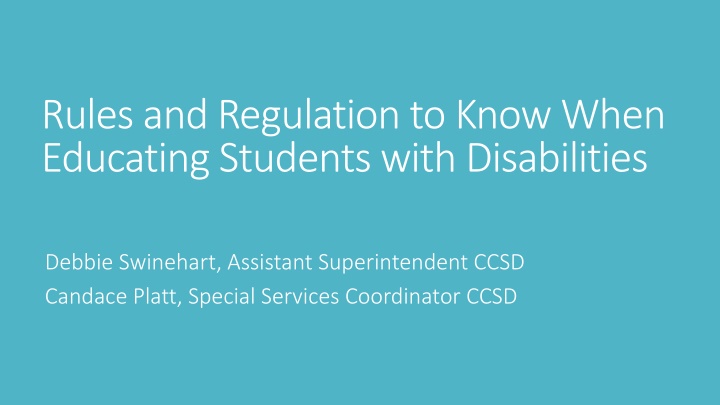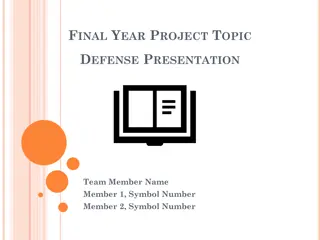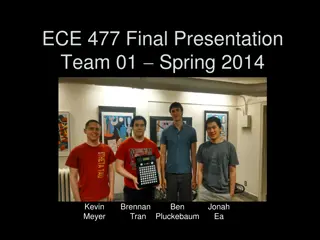
Effective Strategies for Educating Students with Disabilities and At-Risk Students
Discover essential guidelines for educating students with disabilities, including Response to Intervention and Functional Behavior Assessments. Learn about the importance of Executive Function Skills and how to follow Ohio Operating Standards for At-Risk Students. Explore practical approaches to improve academic success and behavior management.
Download Presentation

Please find below an Image/Link to download the presentation.
The content on the website is provided AS IS for your information and personal use only. It may not be sold, licensed, or shared on other websites without obtaining consent from the author. If you encounter any issues during the download, it is possible that the publisher has removed the file from their server.
You are allowed to download the files provided on this website for personal or commercial use, subject to the condition that they are used lawfully. All files are the property of their respective owners.
The content on the website is provided AS IS for your information and personal use only. It may not be sold, licensed, or shared on other websites without obtaining consent from the author.
E N D
Presentation Transcript
Rules and Regulation to Know When Educating Students with Disabilities Debbie Swinehart, Assistant Superintendent CCSD Candace Platt, Special Services Coordinator CCSD
Whats Important When Educating At Risk Students 1. Response To Intervention 2. Following the Ohio Operating Standards for At Risk Students and SWDs 3. Functional Behavior Assessments/Behavioral Intervention Plans
Response To Intervention RTI is a multi-level prevention system that uses data based decision making to identify students that are at risk for academic failure and employing the necessary supplementary interventions for student success. The Structure of RTI in a building has four main components The Structure of RTI in a building has four main components Screening all students three times per year, fall/winter/spring Identifying the area of academic or behavioral need of intervention - data based decisions Identifying a research based/evidence based intervention that targets the area of need multi-level prevention systems (Tier 1) Progress monitoring the students response to the identified intervention.
Center on Response to Intervention www.rti4success.org
Executive Function Skills The executive functions are a set of processes that all have to do with managing oneself and one's resources in order to achieve a goal. It is an umbrella term for the neurologically-based skills involving mental control and self-regulation.
Great Resources www.PBIS.org www.interventioncentral.org/ www.pbisworld.com/ www.margaretsearle.com www.jimwrightonline.com www.nasponline.org, www.osu.edu/teachall/text/behavior/LRBI.htm, www.challengingbehavior.org/do/resources/teaching_tools/ttyc.html www.redandgreenchoices.com www.ldonline.org www.ncld.org www.state.ky.us/agencies/behave/bi/bi.html www.state.ky.us/agencies/behave/bi/ss.html www.ocali.org
Special Education 101 - Evaluations 1. Request for Evaluation: 30 days from date of request to determine if LEA suspects disability and gain consent, 60 days from consent to evaluate and make determination. IEP must be written within 30 days of eligibility determination. Parent consent is required in order to initiate special education services. 2. Procedural Safeguards are in effect at the time a parent or other party suspects a disability this applies to suspension/expulsion. 3. All students must be re-evaluated every three years, unless requested sooner, but no more than once per year. Transfer student timelines (In-State = Re-eval Out of State =Initial 4. Eligibility is based on the need for Special Education which requires Specially Designed Special Education which requires Specially Designed Instruction (to modify the content, methodology or delivery of instruction in order to Instruction (to modify the content, methodology or delivery of instruction in order to meet the unique needs of the student the unique needs of the student, cannot be for the sole purpose of related services or accommodations.
Disability Categories Other Health Impaired Deaf Blindness Specific Learning Disability Multiple Disabilities Hearing Impairment Intellectual Disability Emotional Disturbance Visual Impairment Orthopedic Impairment Speech Language Impairment Autism Developmental Delay (ages -5) Traumatic Brain Injury
IEP Development The IEP must be developed by a team that includes the parent and student, if appropriate. Regular Ed teachers. An IEP team meeting must be held annually, or sooner if the student is not making adequate progress towards the G/O in the IEP. The required IEP team members required IEP team members include, at a minimum, the Regular Education Teacher, Intervention Specialist, District Administrator, Parent, and Student. There are guidelines from ODE to excuse a member of the IEP team. The Student Profile, Goals/Objectives, Related Services, accommodations, modifications and Specially Designed Instruction are determined by the IEP team based on current data that is related to the students academic and behavioral needs. Progress towards G/O must be reported as frequently as non-disabled peers (interims, report card periods, lack of progress). by a team, and
Least Restrictive Environment IDEA provides that to the maximum extent appropriate, children with disabilities, including children in public or private institutions or other care facilities, are educated with children who are not disabled, and that special classes, separate schooling or other removal of children with disabilities from the regular educational environment occurs only when the nature and severity of the disability is such that education in regular classes with the use of supplementary aids and services cannot be achieved satisfactorily. (34 CFR 300.550-300.556) The regular education classroom The regular education classroom, in the school that the student would attend if not disabled, is considered the least restrictive environment and the first placement option discussed before a more restrictive placement is considered. (Parental Consent must be obtained in order to place a student in an educational setting other than the general education classroom) first placement option discussed
Factors to Consider When Deciding LRE The educational benefits available to the SWD in a traditional classroom , supplemented with appropriate aids and services, in comparison to the educational benefits to the SWD from a special education classroom. The non-academic benefits to the SWD from interacting with non-disabled students; and The degree of disruption of the education of other students, resulting in the inability to meet the unique needs of the SWD. LRE cannot be based solely on category of disability, severity of disability, configuration of delivery system, availability of educational/related services, space, or administrative convenience.
Prior Written Notice Prior Written Notice (AKA PR Special Education. The Ohio Department of Education issued a 7 page guidance document on March 17, 2014 that identifies every possible situation in which the district is required Notices and the Procedural Safeguard Notice (Whose IDEA ). Prior Written Notice is one of the first documents requested by the Ohio Department of Education when a parent files a complaint or requests a Due Process Hearing. When a district is required to upload documents to verify whether or not noncompliance issues exist from their Special Education Profile PWN will always be requested. A District can never send too many PWNs, it s the one document that clearly states what decisions the IEP team has made, and what was discussed at an IEP/MFE/MDR meeting. Procedural Safeguards Notice must be provided at least annually to every parent, either electronically or in paper format. AKA PR- -01 01) is the Districts most important document when it comes to required to send Prior Written
Suspension/Expulsion/MDRs Any student suspected of having a disability, identified as having a disability or receiving services via a 504 Plan shall have all rights safeguarded when he or she is being suspended beyond 10 days in a school year or being Recommended For Expulsion. The Ohio Department of Education closely monitors the timelines and paperwork associated with SWDs as it applies to Suspensions and Expulsions. The requirements surrounding this area are frequently followed incorrectly and result in Corrective Action Plans being written at the district level. The district ODE Special Education Profile, Complaints and Due Process will usually expose the district s vulnerability in this area. Data in the State of Ohio indicates that SWDs are suspended and or RFE d at a higher rate than their non-disabled peers. What does your district ODE Special Education Profile tell you?
Cont. For a student exhibiting a pattern of behaviors that is interfering with their education or that of their peers the district is required to convene the team to determine if a Functional Behavior Assessment (FBA) should be conducted and a subsequent Behavioral Intervention Plan (BIP) be written. Prior to conducting a FBA the district is now required to send a PWN stating the district s intent to conduct the FBA, and and get written consent to complete the FBA. The FBA and BIP are completed by the student s IEP team, not just one person, and should include the parent and student when appropriate. When a student has been suspended beyond 10 days the district is required to convene the IEP team to either determine if the student needs to have a FBA completed and BIP written or if an existing BIP continues to be appropriate or needs to be revised.
FBA/MDR Continued If a student has exceeded the 10 days allowable for suspension the IEP team must complete a Manifestation Determination Review within 10 days of recommending a change in placement. If the behavior has been determined behavior has been determined not to be of his or her disability of his or her disability the district may apply the same code of conduct to the SWD as they would a student without a disability. It is up to the IEP to decide if the services in the IEP should be provided during the time of suspension. If a student has exceeded the 10 days allowable for suspension or has been RFE d the IEP team must conduct a Manifestation Determination Review to determine if the behavior in question is a result of the student s disability. If the IEP team determines that the behavior that the behavior is is a manifestation of the child s disability a manifestation of the child s disability the student is returned to his or her educational placement and the IEP team must conduct a FBA and write a BIP or review the existing documents and make changes, if appropriate. not to be a manifestation a manifestation determines
Continued The Ohio Department of Education has developed a Flow Chart to guide school districts through the process of Manifestation Determination Reviews. School Districts should maintain copies of all paperwork related to a suspension, recommendation for expulsion as it applies to the required IDEA documents (consents, PWN, FBA, BIP, district notices, district reports) When completing a PWN specific to Suspensions and RFEs the person responsible for completing the PWN should be diligent in completing the PWN and explaining the decisions that have been made and what the district intends to do. When the IEP team is completing the MDR, it is imperative that the team e thorough in completing that form, it is inappropriate to use a few words or a sentence when responding to the questions on the MDR form.
Continued In all cases if a parent or IEP team member disagrees with the decision reached during a MDR it is the responsibility of the district representative of the IEP team to make the final decision as to whether or not the behavior in question is or is not a manifestation of the child s disability. In the event that the parent disagrees with the final decision the district is required to send a PWN and Whose IDEA, clearly documenting the outcome of the meeting.





















